Study on Power Frequency Breakdown and Decomposition Characteristics of SF6/N2 Gas Mixture
Abstract
1. Introduction
2. Materials and Methods
2.1. Test Platform and Electric Field Simulation
2.2. Test Method and Detection System
3. Test Results and Analysis
3.1. Power Frequency Breakdown Characteristics of SF6/N2 Mixed Gas
3.2. Decomposition Characteristics of SF6/N2 Mixture Under Breakdown Condition
3.2.1. Variation Characteristics of C2F6, CF4, CH4, CO2 and NF3 Production
3.2.2. Variation Characteristics of SO2, SOF2, H2S and COS Production
4. Insulation Strength Calculation
5. Conclusions
- (1)
- In a quasi-uniform electric field, the power–frequency breakdown voltage of the SF6/N2 mixture (mixing ratio 3:7) increases approximately linearly with gas pressure. At 0.5 MPa, the dielectric strength of the mixture is comparable to that of pure SF6 at 0.4 MPa, suggesting that insulation performance can be enhanced by increasing the filling pressure in practical applications. In a slightly non-uniform field, the voltage increase rate declines with pressure, indicating reduced sensitivity and a gradual saturation trend. In an extremely non-uniform field, the breakdown voltage shows minimal variation with pressure and exhibits pronounced saturation behavior.
- (2)
- Decomposition products of SF6/N2 mixtures under power–frequency breakdown include SO2, SOF2, COS, H2S, CO2, C2F6, CF4, CH4, and NF3. Among these, SOF2, CO2, C2F6, and NF3 are primary products, with concentrations decreasing as gas pressure rises. H2S and COS serve as characteristic indicators of severe breakdown events, while NF3 is a distinctive product that differentiates SF6/N2 mixtures from pure SF6.
- (3)
- The critical breakdown field strength method accurately predicts the insulation performance of gaseous dielectrics at low pressures (0.1–0.4 MPa) and serves as a reliable criterion for estimating breakdown voltage in gas-insulated systems for engineering applications.
Author Contributions
Funding
Data Availability Statement
Conflicts of Interest
References
- Rigby, M.; Mühle, J.; Miller, B.R.; Prinn, R.G.; Krummel, P.B.; Steele, L.P.; Fraser, P.J.; Salameh, P.K.; Harth, C.M.; Weiss, R.F.; et al. History of atmospheric SF6 from 1973 to 2008. Atmos. Chem. Phys. 2010, 10, 10305–10320. [Google Scholar] [CrossRef]
- Kieffel, Y.; Irwin, T.; Ponchon, P.; Owens, J. Green gas to replace SF6 in electrical grids. IEEE Power Energy Mag. 2016, 14, 32–39. [Google Scholar] [CrossRef]
- Tefferi, M.; Pyle, F.; Laso, A.; Dauksas, A.; Darko, K.; Uzelac, N.; Scott, A.; Xu, W. Streamer Criterion for Designing Gas-Insulated Medium Voltage Switchgear. In Proceedings of the 2022 IEEE Conference on Electrical Insulation and Dielectric Phenomena (CEIDP), Denver, CO, USA, 30 October–2 November 2022; pp. 451–454. [Google Scholar]
- Bujotzek, M.; Seeger, M. Parameter dependence of gaseous insulation in SF6. IEEE Trans. Dielectr. Electr. Insul. 2013, 20, 845–855. [Google Scholar] [CrossRef]
- Kieffel, Y. Characteristics of g3-an alternative to SF6. In Proceedings of the 2016 IEEE International Conference on Dielectrics, Montpellier, France, 3–7 July 2016; IEEE: Piscataway, NJ, USA, 2016; pp. 880–884. [Google Scholar]
- Zheng, X.; Shen, Y.; Wang, S.; Huang, K.; Cao, D. Selective adsorption of SF6 in covalent and metal–organic frameworks. Chin. J. Chem. Eng. 2021, 39, 88–95. [Google Scholar] [CrossRef]
- Mahdi, A.S.; Abdul-Malek, Z.; Arshad, R.N. SF6 Decomposed Component Analysis for Partial Discharge Diagnosis in GIS: A Review. IEEE Access 2022, 10, 27270–27288. [Google Scholar] [CrossRef]
- Rabie, M.; Christian, M.F. Assessment of eco-friendly gases for electrical insulation to replace the most potent industrial greenhouse gas SF6. Environ. Sci. Technol. 2018, 52, 369–380. [Google Scholar] [CrossRef]
- Ahmed, R.; Abd-Rahman, R.; Ullah, Z.; Ullah, R.; Sami, I.; Yousof, M.F.M. The Insulation Performance of Novel Refrigerant Gas as an Alternative to SF6 for Medium Voltage Switchgear. IEEE Access 2024, 12, 47068–47079. [Google Scholar] [CrossRef]
- Span, R.; Lemmon, E.W.; Jacobsen, R.T.; Wagner, W.; Yokozeki, A. A reference equation of state for the thermodynamic properties of nitrogen for temperatures from 63.151 to 1000 K and pressures to 2200 MPa. J. Phys. Chem. Ref. Data 2000, 29, 1361–1433. [Google Scholar] [CrossRef]
- Shao, T.; Tarasenko, V.F.; Zhang, C.; Beloplotov, D.S.; Yang, W.; Lomaev, M.I.; Zhou, Z.; Sorokin, D.A.; Yan, P. Abnormal polarity effect in nanosecond-pulse breakdown of SF6 and nitrogen. Phys. Lett. A 2014, 378, 1828–1833. [Google Scholar] [CrossRef]
- Tang, J.; Rao, X.; Tang, B.; Liu, X.; Gong, X.; Zeng, F.; Yao, Q. Investigation on SF6 spark decomposition characteristics under different pressures. IEEE Trans. Dielectr. Electr. Insul. 2017, 24, 2066–2076. [Google Scholar] [CrossRef]
- Niemeyer, L. SF6 recycling in electric power equipment. In Gaseous Dielectrics VIII; Springer: Boston, MA, USA, 1998; pp. 431–442. [Google Scholar]
- Li, W. Analysis report on development trend of power transmission and distribution industry. Business Year book of Power Transmission and Distribution Industry 2019–2020. pp. 110–120.
- Hyrenbach, M.; Zache, S. Alternative insulation gas for medium-voltage switchgear. In Proceedings of the 2016 Petroleum and Chemical Industry Conference Europe (PCIC Europe), Berlin, Germany, 14–16 June 2016; IEEE: Piscataway, NJ, USA, 2016; pp. 1–9. [Google Scholar]
- Lenssen, N.J.L.; Schmidt, G.A.; Hansen, J.E.; Menne, M.J.; Persin, A.; Ruedy, R.; Zyss, D. Improvements in the GISTEMP uncertainty model. J. Geophys. Res. Atmos. 2019, 124, 6307–6326. [Google Scholar] [CrossRef]
- Xiao, S.; Shi, S.; Li, Y.; Ye, F.; Li, Y.; Tian, S.; Tang, J.; Zhang, X. Review of decomposition characteristics of eco-friendly gas insulating medium for high-voltage gas-insulated equipment. J. Phys. D Appl. Phys. 2021, 54, 373002. [Google Scholar] [CrossRef]
- Hyrenbach, M.; Hintzen, T.; Müller, P.; Owens, J. Alternative gas insulation in medium-voltage switchgear. In Proceedings of the 23rd International Conference on Electricity Distribution, Lyon, France, 15–18 June 2015; IEEE: Piscataway, NJ, USA, 2015; pp. 1–10. [Google Scholar]
- Xiao, A.; Zhang, A.; Bonk, J.; Owens, J.; DeLorme, M. Recent development of alternative gases to SF6 for high voltage electrical power applications. In Proceedings of the 2020 IEEE International Conference on High Voltage Engineering and Application (ICHVE), Beijing, China, 6–10 September 2020; pp. 1–4. [Google Scholar]
- Qin, Z.Y.; Zheng, Y.; Wei, L.J.; Yang, S.; Zhang, C.; Zhou, W.J. Lightning impulse insulation characteristics of SF6/N2 gas mixture at low temperature. High Volt. Technol. 2017, 43, 3907–3913. [Google Scholar]
- Lin, X.; Li, L.W.; Li, X.T.; Su, A.; Chen, H. Calculation and analysis of cold dielectric recovery characteristics of high voltage SF6/N2 mixed gas circuit breaker. Proc. CSEE 2018, 38, 4620–4630. [Google Scholar]
- Sun, P.C.; Wang, B.T.; Hong, W.F.; Wang, Q.Z. Experimental study on insulation characteristics of SF6/N2 gas mixtures. China Power 2012, 45, 71–75. [Google Scholar]
- Li, X.T. Research on SF6/N2 and SF6/CF4 Discharge Mechanism and Circuit Breaker Dielectric Recovery Characteristics. Ph.D. Thesis, Shenyang University of Technology, Shenyang, China, 2017. [Google Scholar]
- Mahdy, A.M. Assessment of breakdown voltage of SF6/N2 gas mixtures under non-uniform field. IEEE Trans. Dielectr. Electr. Insul. 2011, 18, 607–612. [Google Scholar] [CrossRef]
- Sun, Y.; Li, Z.; Liu, J.; Gao, H.; Zhang, L.; Wang, S.; Sun, L.; Liu, M.; Li, S. Effects of Electric Field Nonuniformity on DC Positive Streamer Discharge of SF6/N2 Mixed Gas. IEEE Trans. Dielectr. Electr. Insul. 2024, 31, 2019–2028. [Google Scholar] [CrossRef]
- Gao, S.; Xiao, H.; Ding, R.; Yin, Z.; Zhuang, T.; Li, H.; Zhan, A.; Ye, F. Characterization of partial discharge decomposition of SF6/N2 gas mixture with different microwater contents. AIP Adv. 2024, 14, 055027. [Google Scholar] [CrossRef]
- Chen, H.; Zeng, X.; Xiao, Y.; Li, H.; Yao, Q.; Zeng, F. Influence of microwater on the decomposition of SF6/N2 gas mixture insulating media in overheating faults. AIP Adv. 2024, 14, 015154. [Google Scholar] [CrossRef]
- Zeng, F.; Wu, S.; Lei, Z.; Li, C.; Tang, J.; Yao, Q.; Miao, Y. SF6 fault decomposition feature component extraction and triangle fault diagnosis method. IEEE Trans. Dielectr. Electr. Insul. 2020, 27, 581–589. [Google Scholar] [CrossRef]
- Tang, J.; Pan, J.Y.; Yao, Q.; Miao, Y.; Zeng, F. Study on decomposition characteristics of SF6 at fault temperature of 300–400 °C. Proc. CSEE 2013, 33, 202–210+25. [Google Scholar]
- Q/GDW 11060-2019; State Grid Corporation of China Technical Specification for SF6/N2 Mixed GAS Insulated Electrical Equipment. China Electric Power Press: Beijing, China, 2019.
- Zeng, F.; Tang, J.; Fan, Q.; Pan, J.; Zhang, X.; Yao, Q.; He, J. Decomposition characteristics of SF6 under thermal fault for temperatures below 400 °C. IEEE Trans. Dielectr. Electr. Insul. 2014, 21, 995–1004. [Google Scholar] [CrossRef]
- Chen, X.; Chen, J. Power frequency breakdown and decomposition characteristics of C4F7N/CO2 mixed gas. J. Shanghai Univ. Electr. Power 2025, 41, 182–189. [Google Scholar]
- Shao, X.J.; Yuan, X.C.; Chen, X.X.; Qian, P.; He, Y.L.; He, Y.F.; Sun, A.B.; Zhang, G.J. Calculation of the reaction rate constant for the generation path of the main decomposition products of SF6 based on transition state theory and density functional theory. Sci. Technol. Eng. 2020, 20, 9415–9420. [Google Scholar]
- Chen, H.L.; Xu, J.Y.; Li, L.W.; Shan, C.W.; Lin, S. Experimental Study on the Breakdown Characteristics of SF6/N2 Mixed Gas with Non-uniform Electric Field. High-Volt. Electr. Appl. 2016, 52, 110–115. [Google Scholar]
- Wang, P.; Lu, Y.; Geng, J.H.; Liu, Y.; Ding, Y.; Wang, Y.; Zhou, S. Research and Verification of Numerical Models for spheroid-plate Gap flow-stable leading Transition in Areas at altitudes of 50 and 2200 m. Proc. CSEE. pp. 1–12. Available online: https://link.cnki.net/urlid/11.2107.TM.20250422.1316.004 (accessed on 1 September 2025).
- Pancheshnyi, S.; Biagi, S.; Bordage, M.; Hagelaar, G.; Morgan, W.; Phelps, A.; Pitchford, L. The LXCat project: Electron scattering cross sections and swarm parameters for low temperature plasma modeling. Chem. Phys. 2012, 398, 148–153. [Google Scholar] [CrossRef]
- Chen, S.; Lin, X.; Gao, K.L.; Geng, Z.X.; Li, X.L. Insulation characteristics of C4F7N/CO2 gas mixture under DC and power frequency voltage. High Volt. Technol. 2025, 1–9. [Google Scholar] [CrossRef]
- Hagelaar, G.J.M.; Pitchford, L.C. Solving the boltzmann equation to obtain electron transport coefficients and rate coefficients for fluid models. Plasma Sources Sci. Technol. 2005, 14, 722–733. [Google Scholar] [CrossRef]
- Cekmen, Z.C.; Dincer, M.S. Effective ionization coefficients and transport parameters in binary and ultradilute SF6-Ar mixtures using Boltzmann equation analysis. J. Phys. D Appl. Phys. 2009, 42, 145208. [Google Scholar] [CrossRef]
- Yan, Z.; Zhu, D.H. High Voltage Insulation Technology, 3rd ed.; Electric Power Press: Beijing, China, 2015; pp. 197–201. [Google Scholar]
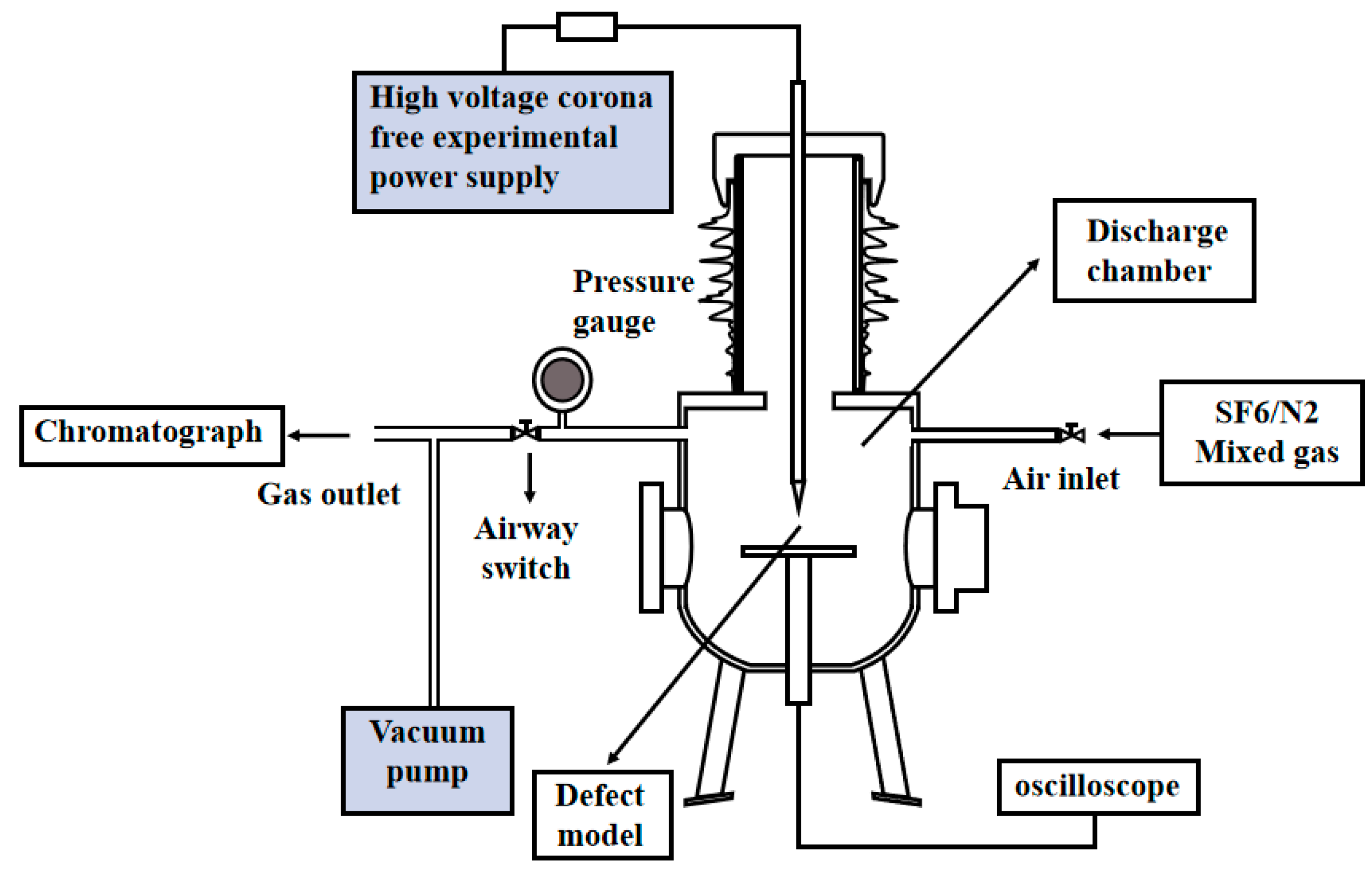
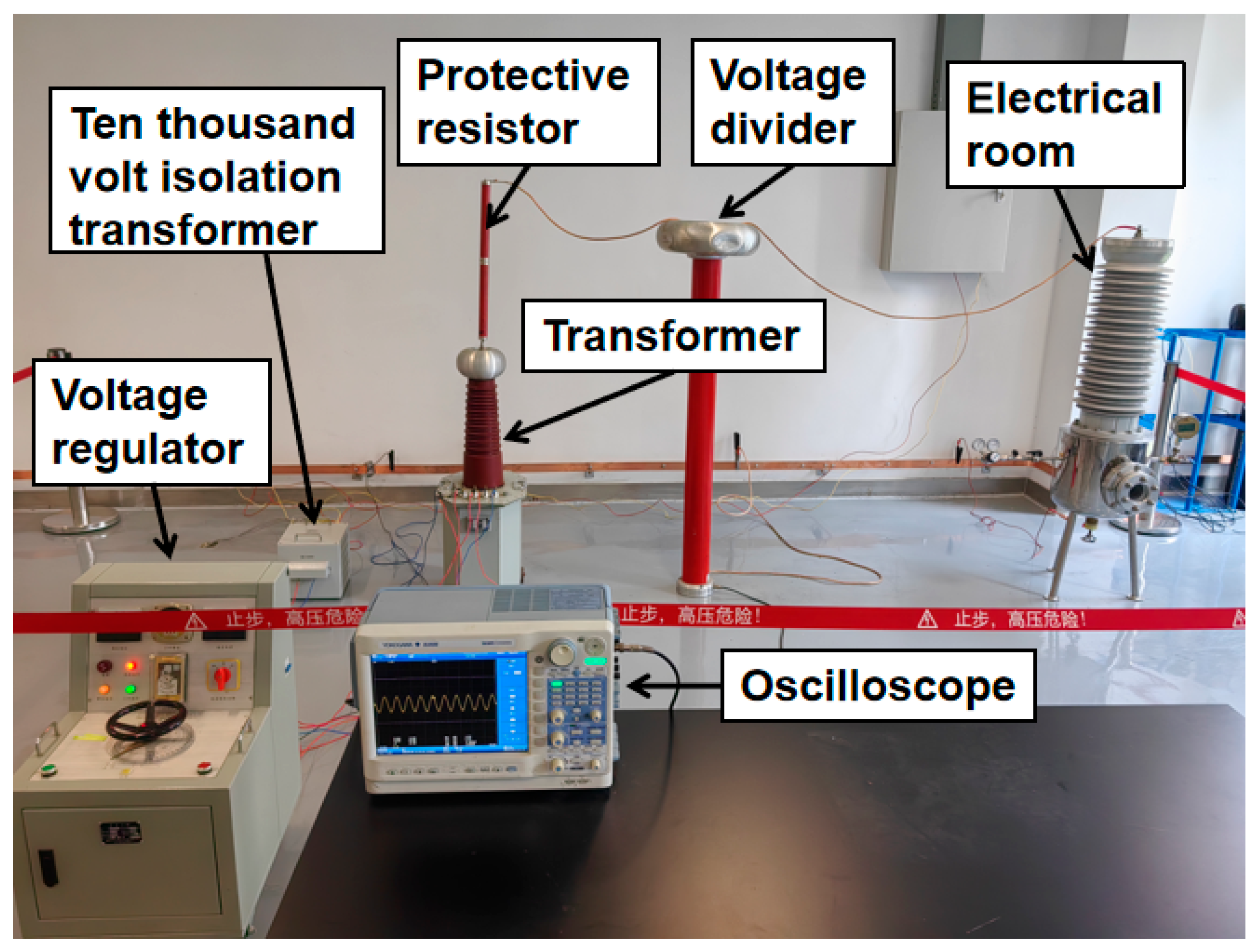
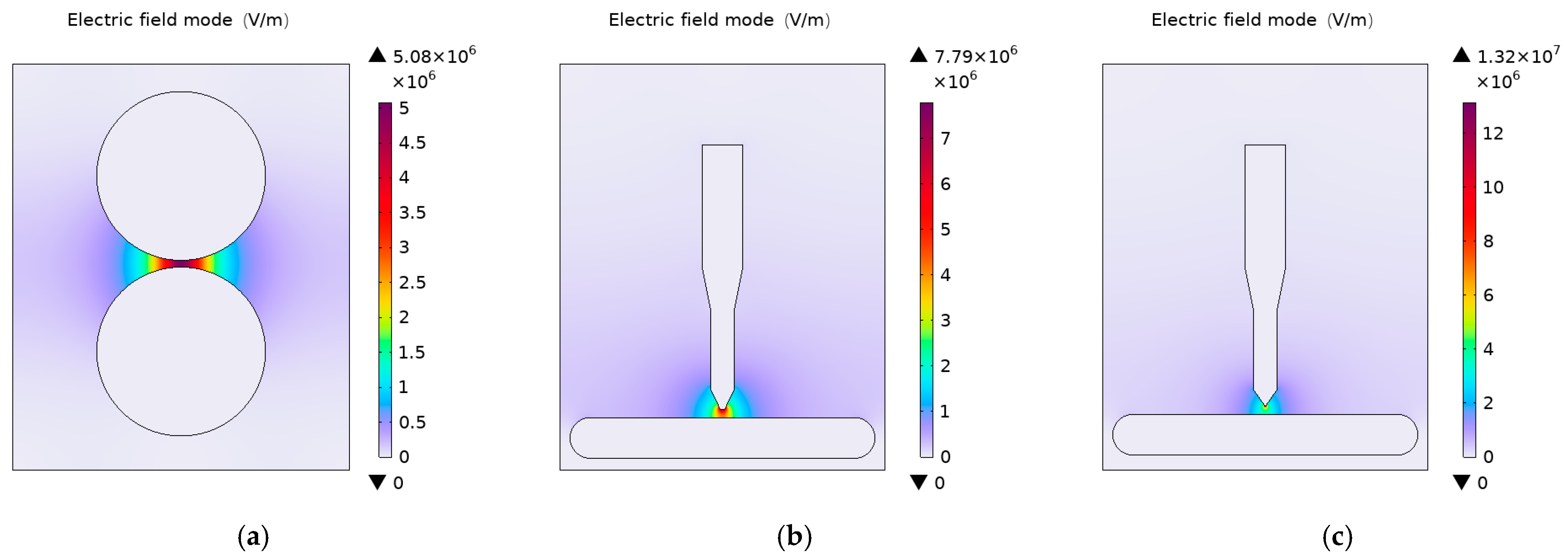


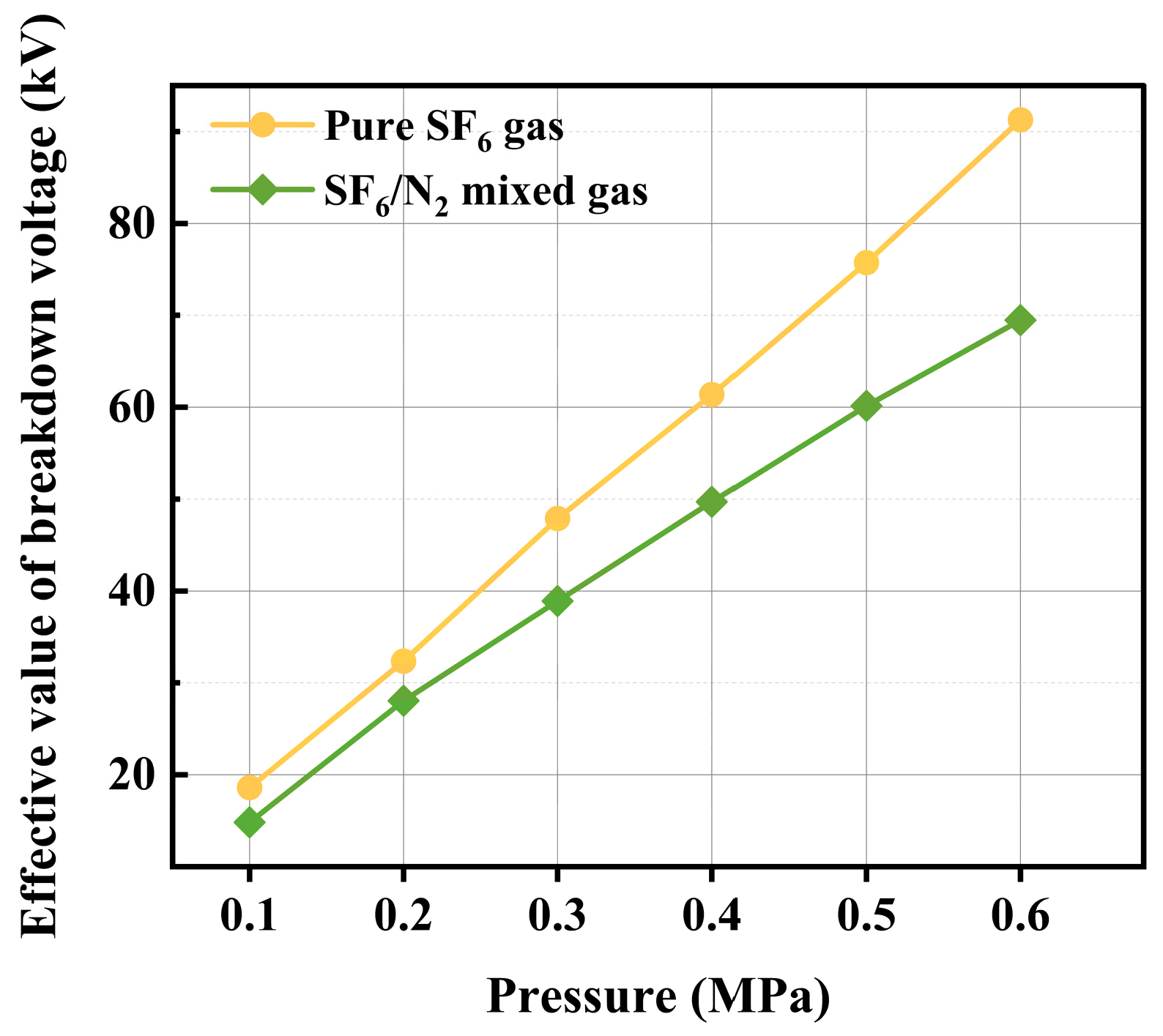

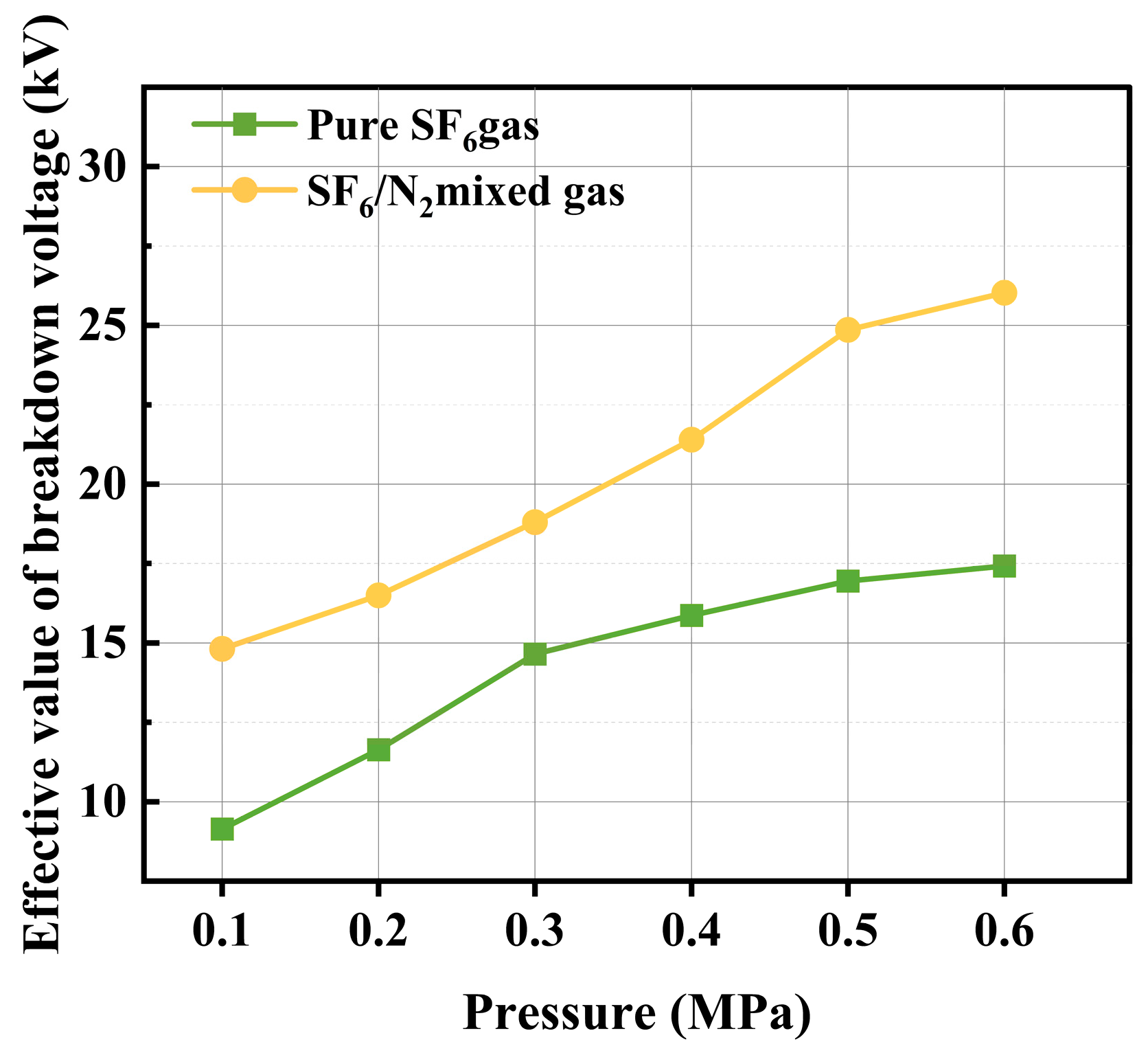
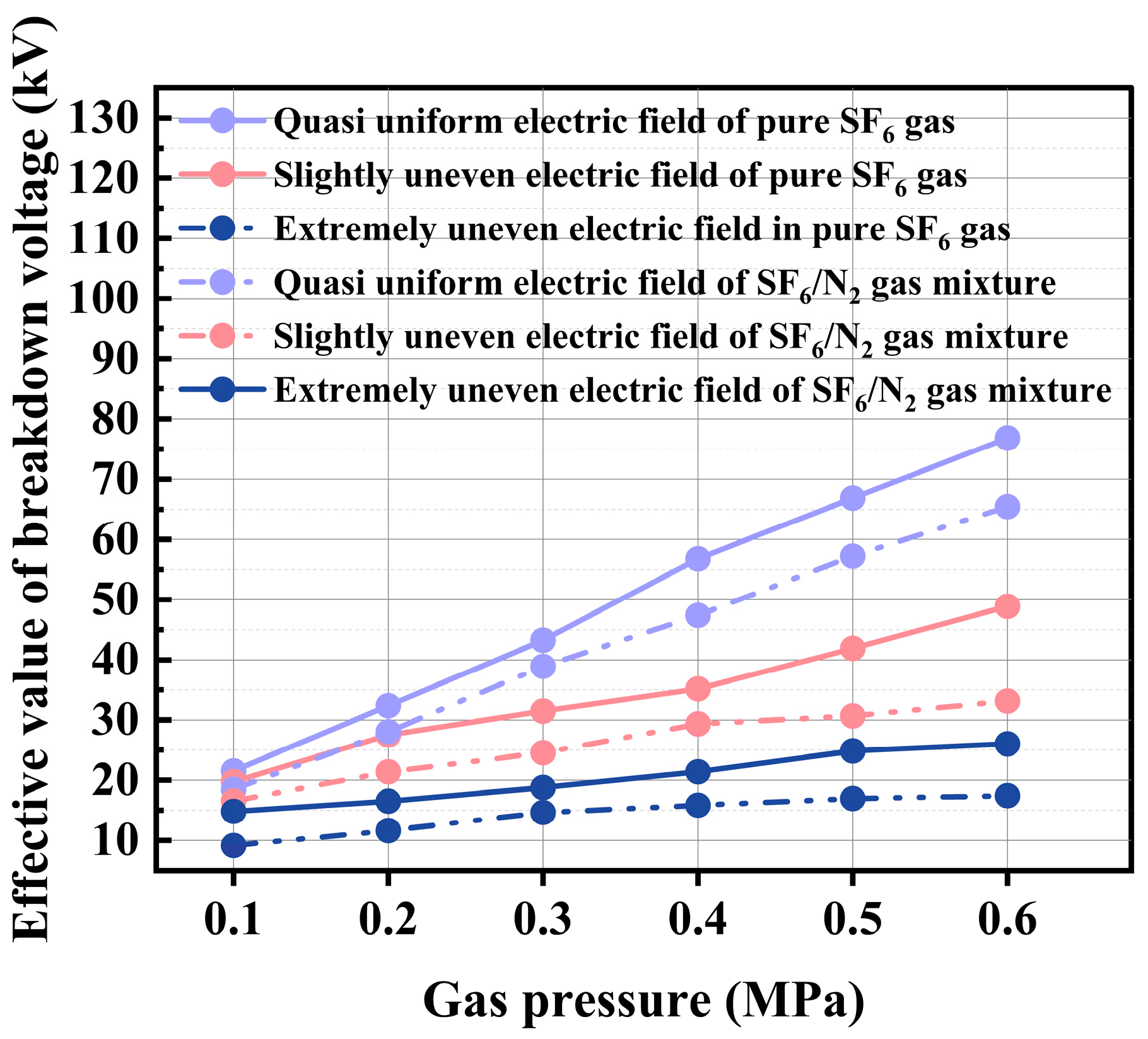

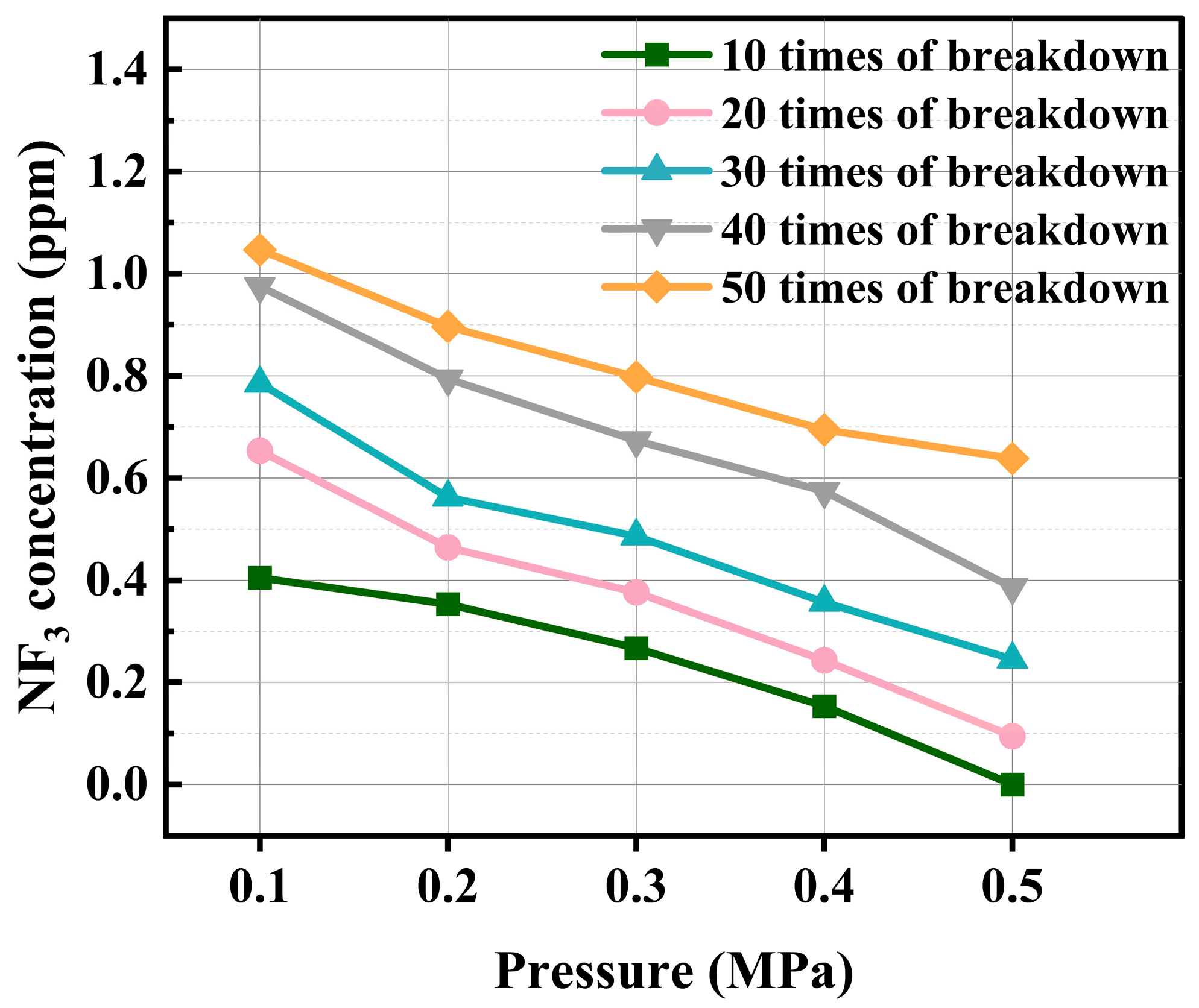

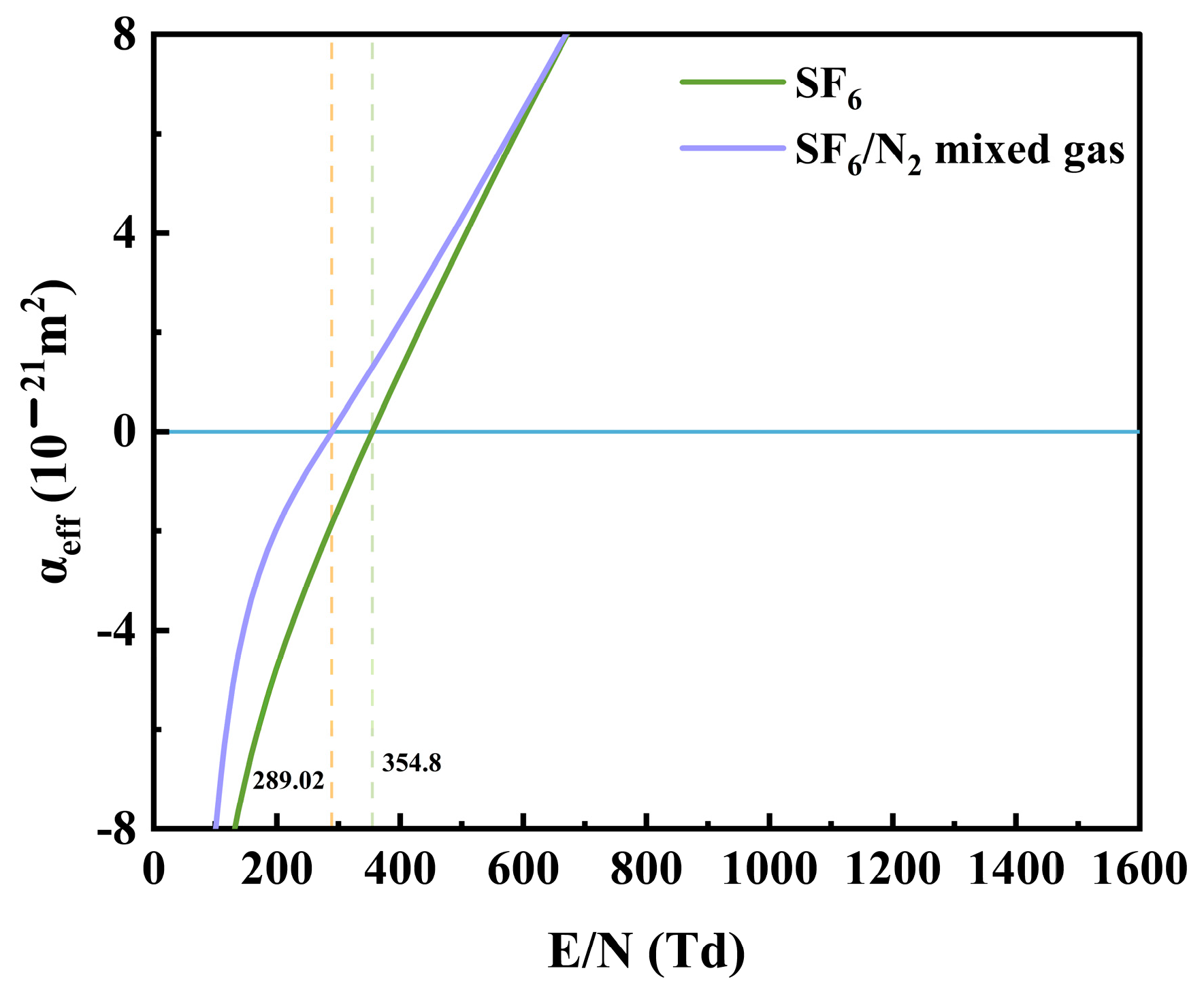

| Electrode | Tip Radius of Curvature (mm) | Plate Electrode Diameter (mm) | Spacing (mm) | f |
|---|---|---|---|---|
| Spherical | - | - | 2 | 1.026 |
| Needle-Plate | 1 | 70 | 2 | 1.538 |
| Needle-Plate | 0.2 | 70 | 2 | 2.54 |
Disclaimer/Publisher’s Note: The statements, opinions and data contained in all publications are solely those of the individual author(s) and contributor(s) and not of MDPI and/or the editor(s). MDPI and/or the editor(s) disclaim responsibility for any injury to people or property resulting from any ideas, methods, instructions or products referred to in the content. |
© 2025 by the authors. Licensee MDPI, Basel, Switzerland. This article is an open access article distributed under the terms and conditions of the Creative Commons Attribution (CC BY) license (https://creativecommons.org/licenses/by/4.0/).
Share and Cite
Wang, J.; Liao, L.; Xia, Y.; Xu, J.; Lin, X.; Geng, Z. Study on Power Frequency Breakdown and Decomposition Characteristics of SF6/N2 Gas Mixture. Energies 2025, 18, 5814. https://doi.org/10.3390/en18215814
Wang J, Liao L, Xia Y, Xu J, Lin X, Geng Z. Study on Power Frequency Breakdown and Decomposition Characteristics of SF6/N2 Gas Mixture. Energies. 2025; 18(21):5814. https://doi.org/10.3390/en18215814
Chicago/Turabian StyleWang, Junbo, Lijuan Liao, Yalong Xia, Jianyuan Xu, Xin Lin, and Zhenxin Geng. 2025. "Study on Power Frequency Breakdown and Decomposition Characteristics of SF6/N2 Gas Mixture" Energies 18, no. 21: 5814. https://doi.org/10.3390/en18215814
APA StyleWang, J., Liao, L., Xia, Y., Xu, J., Lin, X., & Geng, Z. (2025). Study on Power Frequency Breakdown and Decomposition Characteristics of SF6/N2 Gas Mixture. Energies, 18(21), 5814. https://doi.org/10.3390/en18215814





